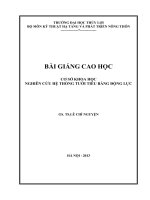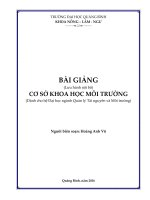Bài giảng Cơ sở khoa học của biến đổi khí hậu (Đại cương về BĐKH) – Phần II: Bài 3 – ĐH KHTN Hà Nội
Bạn đang xem bản rút gọn của tài liệu. Xem và tải ngay bản đầy đủ của tài liệu tại đây (13.87 MB, 22 trang )
VNU HANOI UNIVERSITY OF SCIENCE
REGIONAL CLIMATE MODELING AND CLIMATE CHANGE
CƠ SỞ KHOA HỌC
CỦA BIẾN ĐỔI KHÍ HẬU
(Đại cương về BĐKH)
Phần II
----------------------------------------------------------Phan Van Tan
B03: Hồn lưu khí quyển và khí hậu
Bài 1: Các thành phần của hệ thống khí hậu
Bài 2: Sự truyền bức xạ và khí hậu
Bài 3: Hồn lưu khí quyển và khí hậu
Bài 4: Bề mặt đất, Đại dương và khí hậu
Bài 5: Lịch sử và sự tiến triển của khí hậu Trái đất
Bài 6: Khái niệm về Biến đổi khí hậu
Bài 7: Tác động bức xạ và BĐKH
Bài 8: Biến đổi trong các thành phần của hệ thống khí hậu
Bài 9: Biến đổi của các hiện tượng cực đoan
Bài 10: Giới thiệu về khí hậu Việt Nam
Bài 11: Biến đổi khí hậu ở Việt Nam
Bài 12: Mơ hình hóa khí hậu
Bài 13: Dự tính khí hậu
Bài 14: Xây dựng kịch bản BĐKH
Bài 15: Tác động của BĐKH và tính dễ bị tổn thương do BĐKH
Hồn lưu khí quyển
FIGURE 2.11 Global maps of net incoming radiation. Data from CERES 2000–2013.
Bản đồ phân bố bức xạ Trái đất nhận được (trái) và các thành phần cân bằng năng
lượng bức xạ trung bình vĩ hướng (phải)
| Bức xạ mặt trời nhận được giảm từ xích đạo về các cực
| Phát xạ sóng dài (OLR) đạt cực trị tại các vĩ độ cận nhiệt đới
| Bức xạ thuần dương ở các vĩ độ nhiệt đới và âm từ các vĩ độ ngoài
40o
Hồn lưu khí quyển
FIGURE 2.11 Global maps of net incoming radiation. Data from CERES 2000–2013.
| Bức xạ thuần âm gần các cực và dương ở nhiệt đới
| Năng lượng bức xạ dư thừa ở nhiệt đới và thiếu hụt ở các vùng vĩ
độ cao
Hồn lưu khí quyển
2.9 POLEWARD ENERGY FLUX
2.9 POLEWARD ENERGY FLUX
In the lowest curve of Fig. 2.12, we see that the annual me
tion is positive equatorward of about 40° of latitude and n
ward of that latitude. As illustrated in Fig. 2.13, the energy b
climate system involves only the exchange at the top of the
the transport through the lateral boundaries of the region in
the atmosphere and ocean, and the time rate of change of e
the region. Energy exchange with the solid earth can be negl
FIGURE 2.11
| Năng lượng bức xạ dư thừa ở nhiệt đới phải được vận chuyển về
write the energy balance for the climate system as
Global maps of net incoming radiation. Data from CERES 2000–2013.
các vùng vĩ độ cao mà ở đó thiếu hụt
| Phương trình cân bằng năng lượng:
time rate of change of
the energy
content
where
∂E
∂Eao
= RTOA − ∆Fao
∂t
divergence of the horizontal flux
net incoming radiation at
in the atmosphere
ocean
of the
atmosphere
/∂ttheistopthe
time
rate of change
of theandenergy
content
ao
system, RTOA is the net incoming radiation at the top of the
Cơ chế vận chuyển năng lượng
| Năng lượng dư thừa ở nhiệt đới được vận chuyển về hai đầu
URE 2.13
Diagram
of động
the energy
balance
vertical
column of the cl
cực nhờ
chuyển
của khí
quyểnforvàađại
dương
m in some latitude interval.
| Sự chuyển động đó được gọi là hồn lưu chung khí quyển và
hồn lưu chung đại dương
Sự vận chuyển hướng cực
| Năng lượng dư thừa được tích luỹ
trong khí quyển và đại dương
nhiệt đới
| Năng lượng tổn thất ở các cực là
do phát xạ sóng dài (OLR)
|
Cơng việc của khí quyển và đại
dương là mang lượng năng lượng
từ nơi được tích luỹ đến nơi nó bị
tổn thất (nhờ dòng hướng cực và
dòng đi lên)
| Tuy nhiên, quá trình này bị “cản
trở” bởi lực Coriolis
Sự vận chuyển hướng cực
Hồn lưu khí quyển
Hồn lưu đại dương
Hồn lưu khí quyển
Dao động trong năm của các hệ thống khí áp và hệ quả
Hoàn lưu Walker và ENSO
Tropical Moist
Climates
associated with
Walker
circulation and
Centers of deep
convection
El Niño and Southern Oscillation: ENSO
| El Niño: in Spanish is a (little) boy,
another mean is “the Christ child” è
fishing season is lost
| La Niña: is a (little) girl
Oscillation:
| Normal: H at Tahiti, L at Darwin
| El Niño: L at Tahiti, H at Darwin
| La Niña: H at Tahiti, L at Darwin
Hoàn lưu Walker và ENSO
Sea level variability during the ENSO phases
Hoàn lưu Walker và ENSO
FIGURE 8.10 Schematic diagram showing the atmospheric and oceanic conditions along the equator in (a) La Niña, (b) Normal, and (c)
El Niño conditions. NOAA/PMEL TAO Project.
ENSO phases and related atmosphere-ocean interactions over the
equatorial Pacific region
Hoàn lưu Walker và ENSO
Timeseries of the Southern Oscillation Index (SOI) and the Oceanic
Niño Index (ONI) from Jan 1951 to Dec 2017
(Data from />
Hoàn lưu Walker và ENSO
ENSO and Global Impacts
( />
Hoàn lưu Walker và ENSO
ENSO-related weather conditions
| The maps show worldwide climatic conditions associated with the occurrence of El Niño and La Niña
events, for the periods of December–February and June–August.
| While the indicated conditions often appear during ENSO events, they do not occur with all El Niños or
La Niñas
Gió mùa
The monsoon regions as defined by Ramage (1971)
| Prevailing wind shifts 120° between January and July
| Average frequency of prevailing wind > 40%
| Speed of mean wind exceeds 3 m s-1
| Pressure patterns satisfy a steadiness criterion
( />navmenu.php_tab_4_page_5.0.0.htm)
Gió mùa
Global
tropical
monsoon
systems near
their peak
periods
Gió mùa
Jan
Asian monsoon
| Winter monsoon (East Asian
Monsoon): Flow off the
continent
| Summer monsoon (Indian
Monsoon or South Asian
Monsoon): Flow onto continent
Jul
{ Cross-equatorial!
| SEA monsoon: The air flows
from subtropical high-pressure
bells:
{ West Northern and Southern
Pacific
Gió mùa
The average date of the onset of the Asian summer monsoon varies across
different regions ( />
Mean pressure
systems and
representative
wind vectors
at the surface
for (a) January
and (b) July.
The red
dashed lines
represent the
equatorial
trough (and
monsoon
trough over
Asia)
Gió mùa
The Asian monsoon and how it develops using observational and modeled data
| />









